The iphone12 has attacked the smartphone market. Have users been waiting for this model and does this model have the hallmarks of a market conqueror?
As every year, Apple followers were waiting for the premiere of a new phone, this time it was the iphone12. This year the premiere took place in October, a month later than in previous years.
Have users been waiting impatiently for this phone?
It turns out that probably not entirely.
The level of tension while waiting for the premiere shows that the excitement is starting to diminish. Just look at the search statistics for the word “iphone” just before the smartphone’s release. Maybe it is a bit of the COVID-19 time effect or maybe, users are already almost saturated with new products?
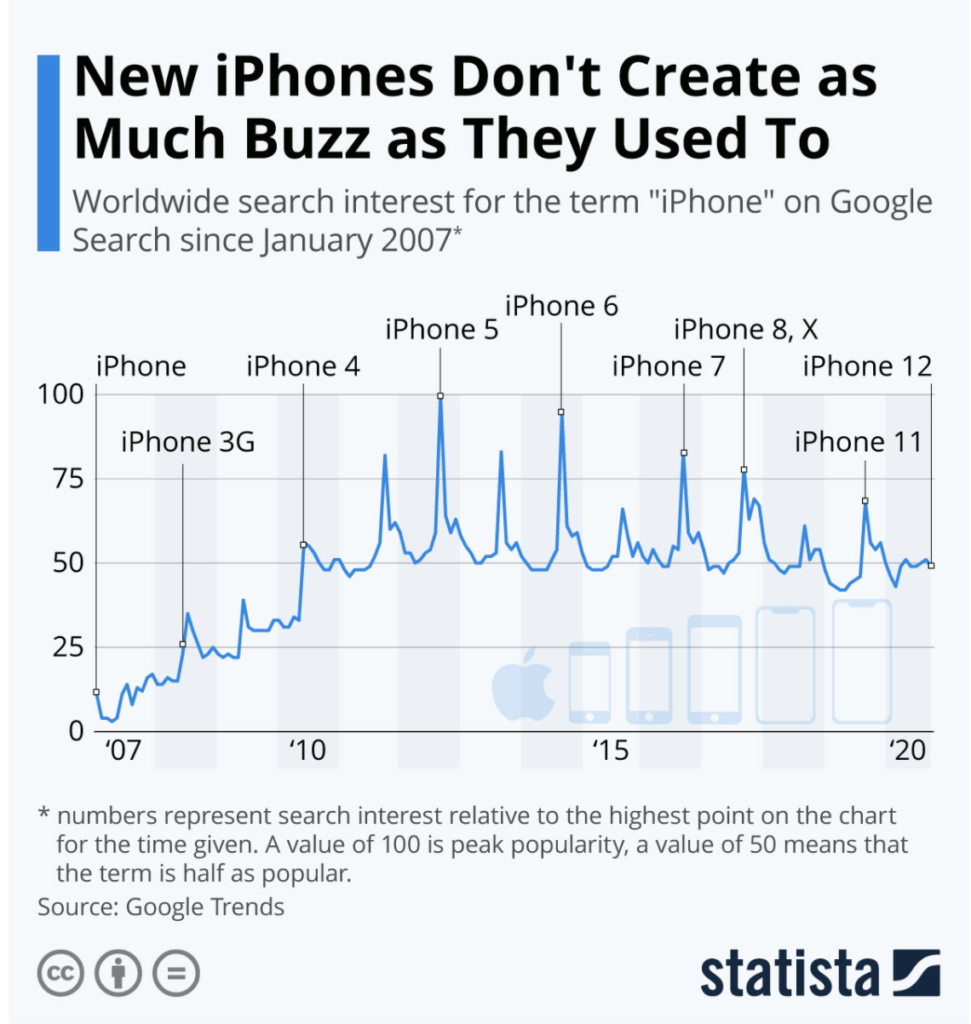
So let’s look at what Apple has shown new.
For dessert, I will give you some flavors from the operator’s kitchen. I will write about the cooperation of mobile operators with telephone suppliers.
What’s new in the iphone12?
Which of the changes to the iphone12 are interesting in my opinion?
The appearance of the iphone12
Changing the look is always the most spectacular part of the new phone’s presentation. Apple has returned to aluminum straight edges. I admit that the cut, metal, cold housings do not fit me. I got used to the rounded shores. Appearance is, of course, a matter of taste, but the most interesting thing is functionality.
The screen is protected by a ceramic shield layer, i.e. new generation glass.
In my opinion, the appearance does not matter much, and certainly spending a few hundred of USD to change. For example, if you have the iphone11 model is not worth it to change it. If someone wants to show up with an iphone, the Apple logo still counts.
Camera in iphone12
The camera issue has become the apple of Apple’s apple of the eye. New lenses, changes in software, and support of the new A14 processor.
I love photography, I am a fan of Canon SLRs, which I have used both amateurs and professionals.
However, I am always pleased to welcome news in this regard in the world of smartphones.
I will not write about new lenses and beauty algorithms. There is a novelty in the new model that caught my attention. The technology borrowed from autonomous cars, the so-called LiDAR.
Apple used the LiDAR (Light Detection and Ranging) technology in the iphone12. Laser Scanner LIDAR measures the depth of the ruthless. It is then calculating the time that they need an invisible beam of light to travel from the transmitter to the object and the back. As a result, in nanoseconds, the camera recognizes all surfaces in the room, even in quite significant darkness.
This technology can be used by AR (Augmented Reality) applications. However, I see a huge field for creators of the new generation of applications that recognize different surfaces and people. Time will show what the creators come up with, but it is certainly a big novelty in photography.
LiDAR reminds me a bit of a Kinect, a motion recognition device connected to the Xbox. Kinect scans players’ movements in real-time. My favorite Kinect app was the Nike Trainer Program. Thanks to Kinect, the application constantly corrected my movements and exercise intensity. It was amazing when the Xbox told me: get your knee up, move faster, etc.
I am waiting impatiently for applications that use LiDAR. What will it be? May not only surveillance applications.
Soon the iphone12 will be additionally equipped with a photo save mode in the ProRAW version. This is what professional photographers are waiting for. It will be happening in the world of SLRs.
The processor in the iphone12
The new processor means more transistors, and more computing power. However, the most important change is even richer support for “artificial intelligence” in the form of hardware, not just software. This can reportedly be seen in the camera app. New possibilities of artificial intelligence and LiDAR allow you to create photos in darker scenery.
According to the manufacturer’s assurances, the new processor is primarily to speed up the system. The question is: How do you appreciate it? I have been using the iphone XR for 2 years. I have not noticed that despite many changes to the software, the device hung, muttered or scraped.
The power of changes on the processor side can be known only when the producers of IOS applications use all introduced hardware innovations in applications. We’ll wait and see.
5G modem in iphone12
YES! This is what iphone fans have been waiting for for 2 years (sic). Support for 5G cellular networks is finally coming. After a long battle with Qualcomm and Intel, Apple introduces a commercial product.
In the 5G modem specification, Apple announced that it will support the most 5G bands, including mmWave bands.
List of bands supported by iphone12:
The list of supported bands is really impressive. Most of the European bands are in the sub-6GHz and mmWave range, but only for the American, Japanese South Korean markets. The n258 band, i.e. 26GHz, which was allocated in Europe, was missing. Perhaps in the future, Apple will add this bandwidth in a new modem.
The differences can be compared with the specifications below.
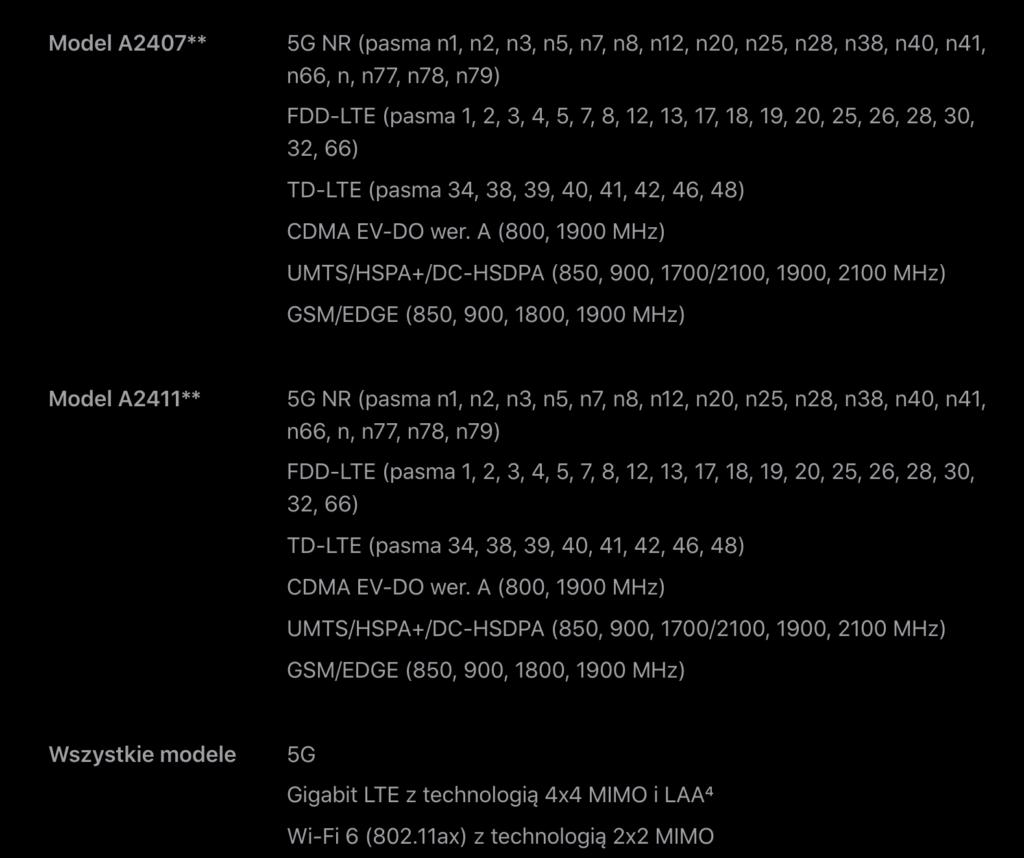
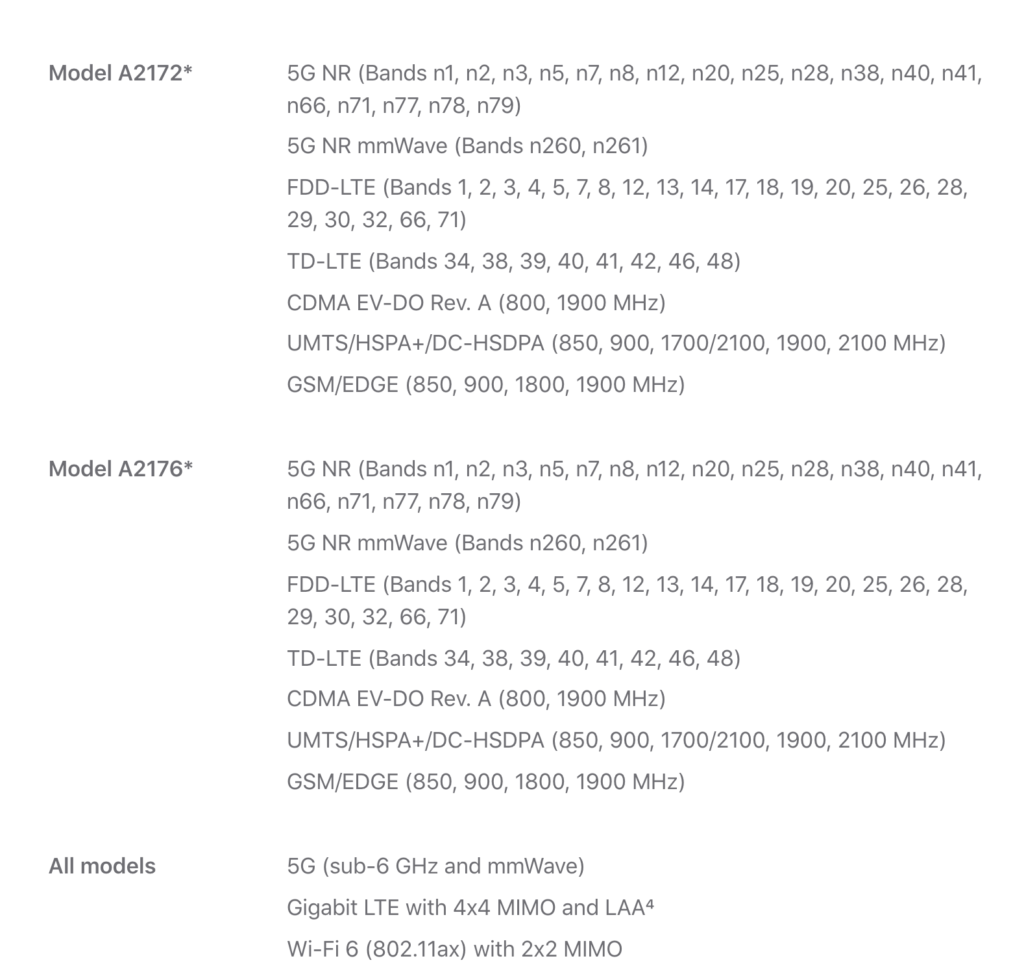
5G modem of iphone12 as a younger brother of 4G modem
In the specification of the 5G modem, I was interested in another new feature. The operating system has optimized the operation of the modem so as to best use the advantages of the 5G modem in cooperation with the 4G modem.
- First, the focus was on optimal battery use. Apple says that when using the 5G transmission, the phone should not use more battery than it was with 4G/LTE.
- Second, when you update a system, your iphone will be using the 4G and slowly updating in the background. The 5G modem will be used when you need an application for quick download, e.g. for video streaming. This functionality has been called Smart Data.
- Thirdly, Apple constructed special 5G antennas in the phone so that the sensitivity of the radio modules was appropriate. This is to positively affect the quality of 5G communication and the speed of transmission.
- Fourth, Apple in cooperation with operators, it has made changes to the phone but also suggested changes in the method of parameterizing the 5G network. It shall improve the quality of the connection for the customer.
In recent days, I found an article that slightly changed my optics regarding the new features of the 5G modem. It turns out that Apple used in the iphone 12 phones batteries with a lower capacity than the competition. So there is speculation that new features are not intended to improve performance but cover up issues with battery capacity. Let’s wait for the first reports from users and analysts, but I have concerns about the intentions of the designers.
To sum up this simple statement. I bet on the 5G modem and the camera with the LiDAR function as the most interesting features.
Now for the operators’ kitchen
The last element of changes in the operation of the 5G modem prompted me to reveal to you a few secrets related to the cooperation of smartphone suppliers and mobile operators.
Do operators prefer Apple or Android?
Perhaps some of you have asked yourself this question. Who are the really more preferred operators, I am not analyzing the financial issues here.
What does the smartphone operating system market look like today?
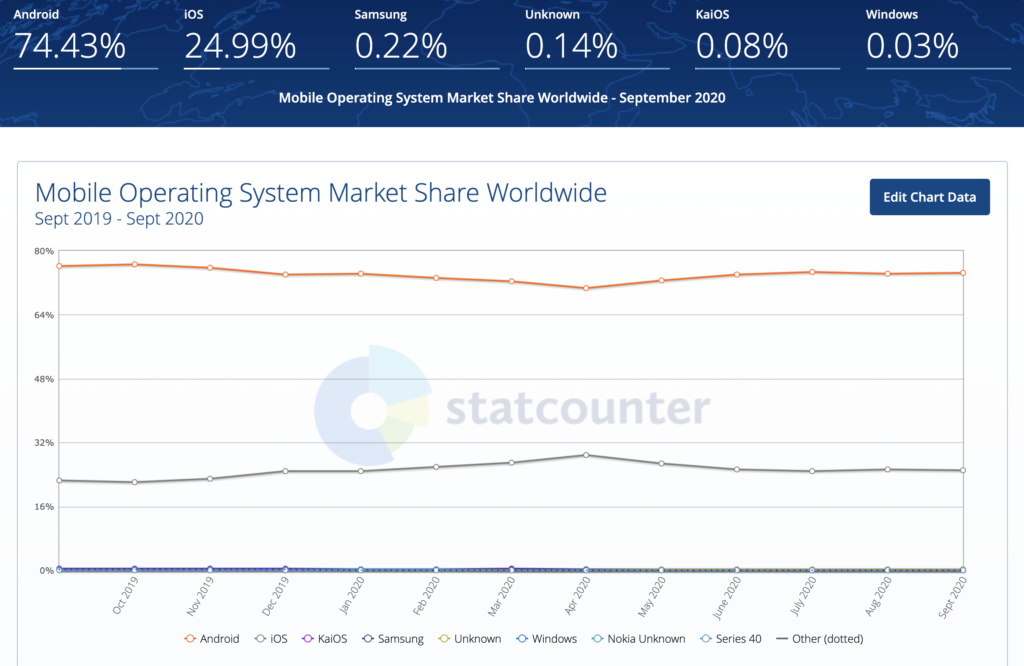
As can be seen in the statistics, Android has a significant advantage in the number of supported devices worldwide with 74.5%. Apple is actively used by approximately 24.99% of users.
In this category, Android reigns supreme, so it can be assumed that users prefer the Google operating system.
If we only looked at the first chart, it could be said that operators and users like Android more.
However, there are a few small aspects that show that in the case of Android, the issue is not seen in such a pink colour.
So let’s take a deeper look to understand which operating system is easier for operators to “control”.
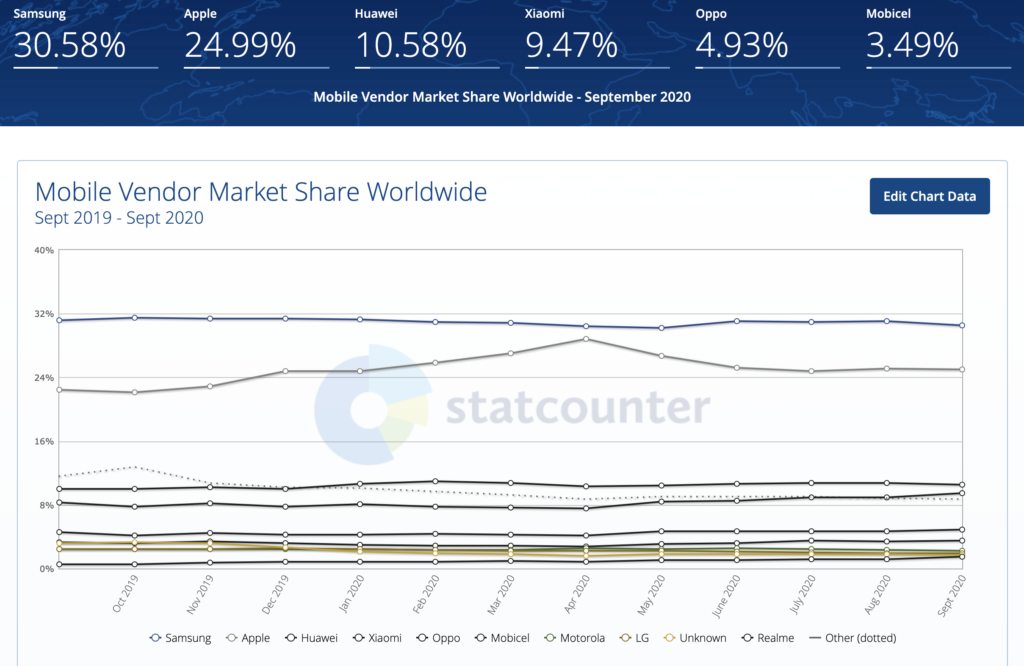
The market division between major Google partners:
- Samsung (30.58%),
- Huawei (10.58%),
- Xiaomi (9.47%),
- Oppo (4.93%),
- LG (1.88%).
The main players, that is Samsung and Huawei, have their own versions of the operating system, the so-called OEM versions. These companies decide which versions of the system to upload and how to manage the call manager. What is the matter, I’ll explain further.
In addition, the analysis of statistics shows that almost half of this market is in the hands of Chinese phone manufacturers. This aspect is important in terms of security and attempts to close access to Android from Chinese companies, which Google did once ineptly with Huawei smartphones.
So Google has a really big problem, thanks to the licensing policy of the Android operating system. Google has no control over Android versions, which consequently also means no control over upgrading it to new versions.
I will just add that month by month the share of Chinese suppliers is growing, and Korean suppliers like LG are falling.
Google, as a manufacturer of Pixel devices, will not be in the top ten.
What are the call managers and their importance for Android and Apple?
The call manager is a part of the operating system that is responsible for managing voice calls, SMS, and video calls. By default, Google offers its system with its call manager, but most informed providers change it to their own version.
When we reflect, we come to the conclusion that this part of the operating system is essential. It is worth mentioning that Google has lost the opportunity to control its technology. In the field of telephone calls, SMS and video it gave control of the call manager to OEM suppliers.
Apple in 2011 discovered that by creating a call manager, can become independent from mobile operators. It could introduce its version of SMS and MMS services under the name iMessage.
When we send iSMS from iphone to iphone, such a message is treated by the operator as a data transfer. However, in a classic call manager would send an SMS to the operator’s network to the SMSC centre. In consequence, the operator could charge the customer and settle accounts with other operators for interconnect services.
What has Apple gained? Integration of services on iphone, iPad and MacBook, but above all, full independence and control over own applications.
When Apple decides to introduce a new version of IOS, it can do it almost immediately. It works efficiently to modernize the operating system platform for individual groups of devices.
Need to mass improve your camera firmware on the latest iphones? Apple’s finger snaps and it’s ready. After years, users are used to accepting operating system changes.
In the case of Android, Google doesn’t have this comfort.
It is an OEM supplier, i.e. Samsung, Huawei etc. must agree to the operating system change and send the change as a software update to users at its own expense.
Let’s take a look at Google’s current situation in terms of controlling its Android versions.
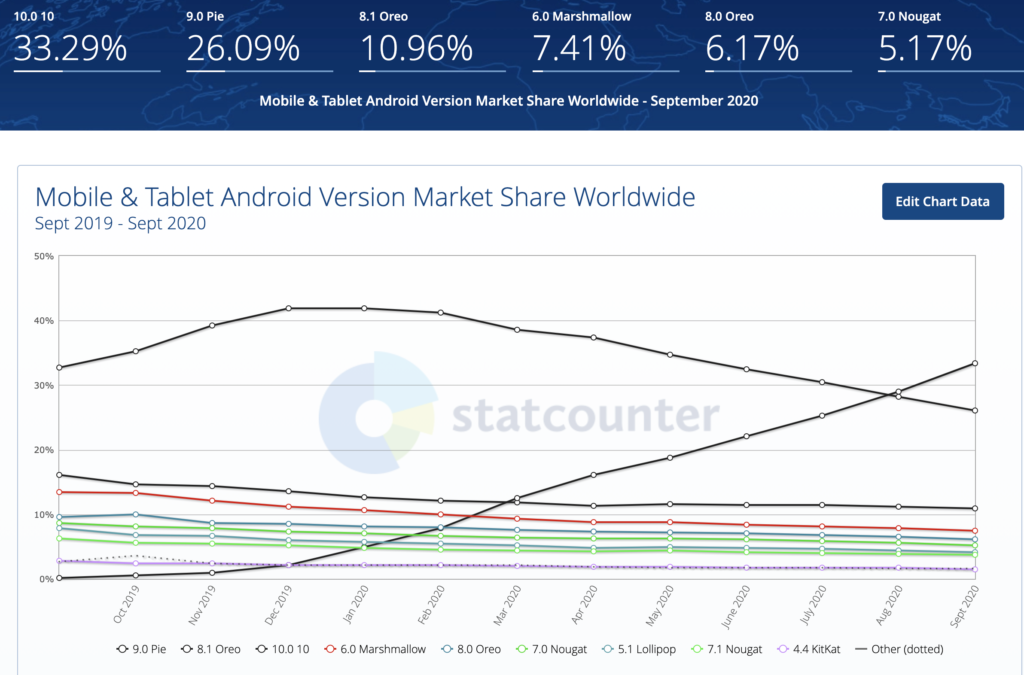
It is clear that there is no single dominant version, although the latest versions 10, 9 and 8 statistically dominate.
I could not find any statistics that would additionally show this division into individual phone providers.
Now let’s look at Apple’s software versions.
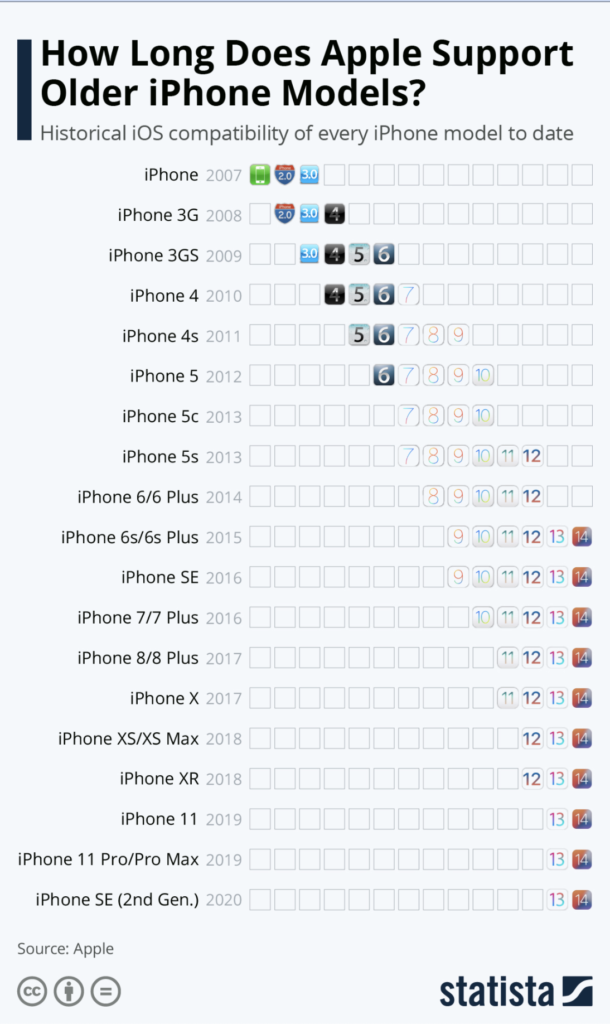
Practically from 2015, all platforms can be upgraded to version 14. All Apple software news goes to almost the entire group of iPhone users.
Do you feel the difference?
It is colossal from the perspective of mobile operators.
Apple has become independent from the requirements of operators and application providers and can develop services (almost freely) on its own platform.
Apple’s family cloud is a flagship product that would never be created in such a form in cooperation with operators.
And here it is worthwhile to answer the question with whom it is easier for operators to cooperate when the operator and smartphone supplier want to implement a technology together. An example is WiFi calling.
Cooperation of operators with Apple
When an operator wants to equip a smartphone with a service compliant with 3GPP standards, for example, Volte, Wifi calling, or RCS, he needs support on the phone from the call manager.
In addition, it must agree on the terms of operation of these applications with smartphone suppliers.
In the case of Apple, the matter is of course simpler, because Apple has full control over all versions of the IOS operating system. If the operator agrees with Apple changes, it does so immediately for all users of the supported versions.
You can now see the strategic essence of “dominating” the call manager application. Simple and direct.
Almost. It is not trivial to get on the list of Apple priorities, because the calendar is always busy, but when it is done, things are rushing at the speed of light and news.
Cooperation of operators with Google (Android)
When an operator introduces Android-based services, he has to settle all issues not with Google, but with the entire group of Android smartphone OEMs.
It is even a nightmare and a double one, because not every telephone supplier is willing to work with the operator on an application that the operator cares about.
The smartphone supplier has its priorities because it prefers to sell as many new devices as possible. It is for this reason that vendors do not want to patch applications and operating systems on older device models. They mainly focus on selling.
Is Apple’s strict workaround or a distributed Android then a friend of the operator and customer?
Apple is the winner in this category, even though its market share is much lower. As you can see, not always bigger, maybe more.
But will it always be like this? Listen to what my colleague predicts in this matter and I fully agree with him.
What will the future of smartphone operating systems look like?
There will be new operating system vendors in the future. As we know, the result of the US-China war in the field of telecommunications is Huawei’s announcement to create its own version of the system (Android- HarmonyOS).
But according to Kornel from Play (which I agree with) the future will be in the use of “Putters”.
A “putter” is a device that will have only “one” application. It will be a web browser.
Gradually, all services are moved to the cloud. Operators will build 5G networks based on the architecture of MEC/EDGE servers located very close to the customer. So why not do all services on the basis of remote access to the application on the cloud?
The client and operator will not have to worry about the version of the application and the operating system. In this matter, life becomes easier.
It is an interesting concept, but I would expect its materialization in 2025+.
What do you think about it? Let us warm up the discussion on this point. I miss your opinion on this.
Feel free to comment.

Pingback: Does your mobile phone support 5G? • https://prostoibezposrednio.pl
Comments are closed.